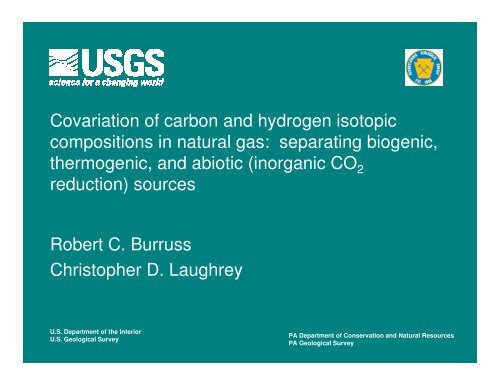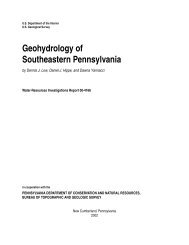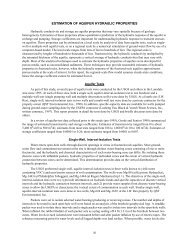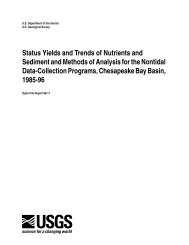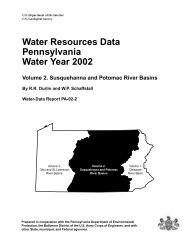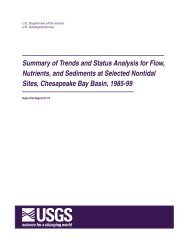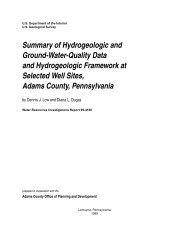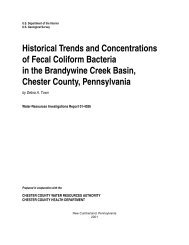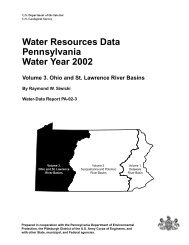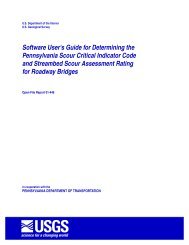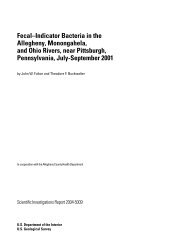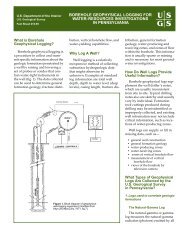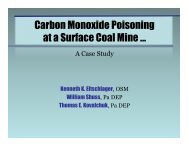Covariation of carbon and hydrogen isotopic compositions in natural ...
Covariation of carbon and hydrogen isotopic compositions in natural ...
Covariation of carbon and hydrogen isotopic compositions in natural ...
Create successful ePaper yourself
Turn your PDF publications into a flip-book with our unique Google optimized e-Paper software.
<strong>Covariation</strong> <strong>of</strong> <strong>carbon</strong> <strong>and</strong> <strong>hydrogen</strong> <strong>isotopic</strong><br />
<strong>compositions</strong> <strong>in</strong> <strong>natural</strong> gas: separat<strong>in</strong>g biogenic,<br />
thermogenic, <strong>and</strong> abiotic (<strong>in</strong>organic CO2 reduction) sources<br />
Robert C. Burruss<br />
Christopher D. Laughrey<br />
U.S. Department <strong>of</strong> the Interior<br />
U.S. Geological Survey<br />
PA Department <strong>of</strong> Conservation <strong>and</strong> Natural Resources<br />
PA Geological Survey
“I believe <strong>in</strong> <strong>natural</strong> gas as a clean,<br />
cheap alternative to fossil fuels.”<br />
“Natural gas is cheap, abundant<br />
<strong>and</strong> clean compared to fossil fuels.”<br />
- Nancy Pelosi on Meet the Press, August 2009
Correlat<strong>in</strong>g <strong>natural</strong> gases <strong>in</strong><br />
groundwater, shows, <strong>and</strong> seeps to<br />
subsurface accumulations or to<br />
possible source rocks can be difficult:<br />
• A range <strong>of</strong> processes affect gas composition<br />
• A limited number <strong>of</strong> variables were used to<br />
characterize gas <strong>in</strong> the past
Stable isotopes <strong>of</strong> <strong>carbon</strong> <strong>and</strong><br />
• C1 – C5<br />
• Provide maximum<br />
possible <strong>in</strong>formation<br />
on:<br />
– Orig<strong>in</strong><br />
– Mix<strong>in</strong>g<br />
– alteration<br />
<strong>hydrogen</strong>:
Goals<br />
• Dist<strong>in</strong>guish gas sources<br />
– Thermogenic<br />
– Biogenic (microbial)<br />
– Abiotic CO 2 reduction, Fischer - Tropsch reactions<br />
• Identify alteration processes<br />
– Mix<strong>in</strong>g<br />
– Raleigh fractionation<br />
• Consistency with theoretical k<strong>in</strong>etic models<br />
• Use all possible measurements
Outl<strong>in</strong>e<br />
• Basics<br />
– Gas generation processes<br />
– Isotope fractionation <strong>in</strong> hydro<strong>carbon</strong>s (HC)<br />
• St<strong>and</strong>ard displays <strong>of</strong> HC isotope data<br />
– Bernard plot<br />
– Schoell plot<br />
– Chung’s <strong>natural</strong> gas plot (NGP)<br />
• Examples <strong>of</strong> source, mix<strong>in</strong>g, alteration<br />
– North Slope, Appalachians, New Engl<strong>and</strong><br />
• Conclusion: 13 C <strong>and</strong> 2 H on all HC gases yield more<br />
<strong>in</strong>formation, <strong>and</strong> therefore stronger <strong>in</strong>terpretations
Nomenclature<br />
δ = Rx - R ( std ) x 1000<br />
Rstd δ units: parts per thous<strong>and</strong>,<br />
per mil or ‰<br />
Where:<br />
Rx = 13C/ 12C or 2H/ 1H (also D/H) <strong>in</strong> sample<br />
<strong>and</strong><br />
Rstd = ratio <strong>in</strong> st<strong>and</strong>ard: 13C/ 12C, PDB; 2H/ 1 Rstd = ratio <strong>in</strong> st<strong>and</strong>ard: C/ C, PDB; H/ H, VSMOW<br />
α A-B = R A<br />
R B<br />
α A-B = K 1/n<br />
Where K is the equilibrium constant for the exchange<br />
reaction for n atoms exchanged
Organic Reaction Facies
THE MAJOR SOURCES OF<br />
HYDROCARBON NATURAL GASES:<br />
• Methanogenic<br />
bacteria<br />
• All types <strong>of</strong> kerogen<br />
• Coal<br />
• Oil <strong>in</strong> source <strong>and</strong><br />
reservoir rocks
Sources <strong>of</strong> <strong>natural</strong> gas:<br />
• The major nonhydro<strong>carbon</strong> gases - CO 2, H 2S,<br />
<strong>and</strong> N 2 – are formed by both organic <strong>and</strong><br />
<strong>in</strong>organic processes. Associated He <strong>and</strong> Ar<br />
orig<strong>in</strong>ate <strong>in</strong> both the crust <strong>and</strong> mantle.<br />
• All known commercial hydro<strong>carbon</strong> gas<br />
accumulations are biogenic <strong>in</strong> orig<strong>in</strong>:<br />
– Decomposition <strong>of</strong> organic matter <strong>in</strong> the earth’s crust<br />
– No known commercial abiogenic methane<br />
accumulations exist based on stable isotope<br />
measurements.
-Tissot <strong>and</strong> Welte, 1984)
-Howell <strong>and</strong><br />
others, 1993
Generation <strong>of</strong> gases from organic<br />
matter with <strong>in</strong>creas<strong>in</strong>g temperature:<br />
• Diagenesis:<br />
– microbial methane generation<br />
up to ~ 50°C<br />
– ~ 20% methane <strong>in</strong><br />
conventional reservoirs<br />
– Important <strong>in</strong> some shale<br />
reservoirs <strong>in</strong> the Michigan <strong>and</strong><br />
Ill<strong>in</strong>ois bas<strong>in</strong>s<br />
• Primary crack<strong>in</strong>g:<br />
– thermal crack<strong>in</strong>g <strong>of</strong> kerogen<br />
<strong>and</strong> coal to generate methane<br />
– ~25% to 40% <strong>of</strong> gases<br />
• Secondary crack<strong>in</strong>g:<br />
– thermal crack<strong>in</strong>g <strong>of</strong> oil<br />
– ~40% to 55% <strong>of</strong> gases<br />
• Metagenesis?<br />
- Hunt, 1996
Microbial Gas Generation<br />
• Biogenic vs. microbial or<br />
bacterial gas<br />
• C1/(C2 + C3) >> 100<br />
• δ13C1 < 60 permil<br />
• δDC1 < 150 permil<br />
• Covariance <strong>of</strong> δD values <strong>of</strong><br />
formation water <strong>and</strong> CH 4<br />
• Alkal<strong>in</strong>ity <strong>of</strong> associated formation<br />
water (> 10 meq/kg)<br />
• Positive δ 13 C <strong>of</strong> DIC (> 10<br />
permil)<br />
• Microbial fermentation<br />
• CO 2 reduction
Microbial Gas Generation
CHO Reactions <strong>in</strong> Crustal Rocks<br />
Crack<strong>in</strong>g <strong>of</strong> sedimentary OM:<br />
[(C xH y)-CH 3 ] Kerogen ---> CH 4 + C xH (y-1)<br />
[(C xH y)-C 2H 5 ] Kerogen ---> C 2H 6 + C xH (y-1)<br />
Anthracite grade:<br />
C20H4 ---> 19C + CH4 C C20H 20H 4 + 2H 2H2O 2O ---> 17C + 2CH 4 + CO 2<br />
Graphite buffered, metamorphic fluids:<br />
2C + 2H 2O = CH 4 + CO 2<br />
Fischer-Tropsch Type:<br />
CO 2 + 4H 2 = CH 4 + 2H 2O<br />
2CO 2 + 7H 2 = C 2H 6 + 4H 2O<br />
nCO 2 + (3n+1)H 2 = C nH 2n+2 + 2nH 2O
Schoell (Whiticar) diagram<br />
From Whiticar, 1999
Bernard diagram
10000<br />
1000<br />
C 1/C 2+<br />
100<br />
10<br />
δ 13 C Methane vs Gas Dryness<br />
Microbial<br />
Gas hydrate<br />
dry<strong>in</strong>g effect<br />
1<br />
-90 -80 -70 -60 -50 -40 -30 -20<br />
δ 13 C<br />
Thermogenic<br />
Gubik<br />
Simpson<br />
Tarn<br />
Umiat<br />
West Sak<br />
Wolf Creek<br />
Alp<strong>in</strong>e<br />
E. Barrow<br />
Kalubik<br />
Kuparuk<br />
Po<strong>in</strong>t MacIntyre<br />
S. Barrow<br />
Walakpa<br />
Endicott<br />
Liberty Unit<br />
Prudhoe Bay<br />
Prudhoe Lisburne Pool<br />
Individual Wells
1000<br />
100<br />
C 1/C 2+<br />
10<br />
1<br />
Bernard plot<br />
-60 -55 -50 -45 -40 -35 -30 -25 -20<br />
δ<br />
13 C1<br />
TBR<br />
LSRA<br />
Lee Cty, VA<br />
Rome Trough/Homer<br />
Swan Crk, TN<br />
L&B, 98<br />
J,D, &K, NYS
Methane Isotopic Composition<br />
δ 13 C<br />
-65 -55 -45 -35 -25<br />
-350<br />
-300<br />
-250<br />
δδD<br />
-200<br />
-150<br />
-100<br />
Microbial<br />
Oil-associated<br />
Mixed Microbial<br />
<strong>and</strong> Thermogenic<br />
Cond.<br />
associated<br />
Non-associated<br />
Thermogenic<br />
Gubik<br />
Simpson<br />
Tarn<br />
Umiat<br />
West Sak<br />
Wolf Creek<br />
Alp<strong>in</strong>e<br />
E. Barrow<br />
Kalubik<br />
Kuparuk<br />
Po<strong>in</strong>t MacIntyre<br />
S. Barrow<br />
Walakpa<br />
Prudhoe Bay<br />
Prudhoe Lisburne Pool
Lower Paleozoic gases compared to sources<br />
δ D<br />
δ 13 C, methane<br />
Grugan
Chung, et al., 1988, crack<strong>in</strong>g model <strong>and</strong> the <strong>natural</strong><br />
gas plot (NGP)<br />
• Consider crack<strong>in</strong>g <strong>of</strong> gases from kerogen with homogeneous <strong>isotopic</strong><br />
composition, δ 13 C p<br />
• All gases form by same reaction mechanism<br />
• Parent molecules (kerogen or oil) are structurally similar<br />
• No condensation reactions form gases<br />
K KR - C<br />
KR - C - C<br />
KR - C - C - C<br />
KR - C - C - C - C<br />
KR - C - C - C - C - C<br />
KR - C - C - C - C - C - C<br />
Cm Cp Cn Isotopic composition <strong>of</strong> C Cn δ 13 C n = [δ 13 C m + (n-1) δ 13 C p]/n<br />
Rearrang<strong>in</strong>g:<br />
δC n = -1/n(δC p - δC m) + δC p<br />
Where:<br />
δC p is δ 13 C <strong>of</strong> parent<br />
δC m is δ 13 C <strong>of</strong> l<strong>in</strong>k C<br />
δC n is δ 13 C <strong>of</strong> gas molecule
Natural Gas Plot (Chung, et al.)<br />
ε - -15‰
Ab <strong>in</strong>itio calculations, Y. Tang, et al., 2000, GCA, assum<strong>in</strong>g non-cleaved C is 0 per mil<br />
δ<br />
0<br />
-10<br />
-20<br />
13 Cn<br />
-30<br />
-40<br />
-50<br />
-60<br />
Hexane precursor<br />
300 K<br />
400 K<br />
500 K<br />
600 K<br />
0 0.1 0.2 0.3 0.4 0.5 0.6 0.7 0.8 0.9 1<br />
1/C n
North Slope, Alaska: Selective isotope reversals due to microbial oxidation<br />
-25<br />
-30<br />
-35<br />
δ 13 C,<br />
Cn -40<br />
-45<br />
-50<br />
-55<br />
n-pentane<br />
W. Sak #17 (Kup. C)<br />
Prudhoe #15-10<br />
Prudhoe #16-10<br />
W. End Test #1<br />
Sag Delta #8<br />
Sag Delta #10<br />
Mukluk DST4<br />
Prudhoe, Eileen<br />
Prudhoe, Ma<strong>in</strong><br />
Prudhoe, Ma<strong>in</strong><br />
Liberty Unit<br />
n-butane<br />
propane<br />
ethane<br />
Prudhoe Bay Area Gases<br />
methane<br />
0 0.2 0.4 0.6 0.8 1<br />
1/C n<br />
δ<br />
13<br />
Cn -25<br />
-30<br />
-35<br />
-40<br />
-45<br />
-50<br />
-55<br />
-60<br />
West Sak<br />
Tarn<br />
Kalubik<br />
Greater Prudhoe Bay area fields<br />
Kuparuk River<br />
Pt. MacIntyre<br />
Alp<strong>in</strong>e<br />
Prudhoe Bay G.C.<br />
Prudhoe Lisburne<br />
0 0.2 0.4 0.6 0.8 1<br />
1/C n
Reservoir <strong>in</strong>tervals <strong>and</strong><br />
distribution <strong>of</strong> gas reservoirs
Natural gas plot<br />
samples from bas<strong>in</strong>-center LSRA
Natural Gas Plot<br />
Ordovician Reservoirs, Trenton-Black River Fm., NY, PA
Natural Gas Plot<br />
Abiogenic, Kidd Creek gases.
_ 13 C (ä)<br />
-20<br />
-25<br />
-30<br />
-35<br />
-40<br />
-45<br />
-50<br />
Range <strong>of</strong><br />
possible<br />
source rock<br />
δ 13 C<br />
-55<br />
0 0.2 0.4 0.6 0.8 1<br />
Figure 5a<br />
1/C n<br />
<strong>in</strong>creas<strong>in</strong>g<br />
depth<br />
127 o C<br />
possible<br />
endmember<br />
227 o C<br />
butane propane ethane methane<br />
δ 13 C organic matter range:<br />
-34 to -24 ‰<br />
-25<br />
-35<br />
__ 13 C<br />
-45<br />
-55<br />
-65<br />
Figure 5b<br />
Range <strong>of</strong><br />
possible<br />
source<br />
Gases generated from two types<br />
<strong>of</strong> organic matter <strong>in</strong> Middle<br />
Ordovician age source rocks,<br />
Utica/Antes, Appalachian bas<strong>in</strong><br />
<strong>in</strong>creas<strong>in</strong>g<br />
depth<br />
possible<br />
endmember<br />
127 o C<br />
227 o C<br />
butane propane ethane methane<br />
0 0.2 0.4 0.6 0.8 1<br />
1/C n
-32<br />
δ 13 C<br />
ethane<br />
Mix<strong>in</strong>g between OAG <strong>and</strong> Sil. NAG<br />
-37<br />
-42<br />
Sil. NAG<br />
Ord. NAG<br />
Sil. OAG<br />
Ord. OAG<br />
0 0.5 1 1.5 2 2.5 3<br />
1/mol % ethane<br />
-25<br />
-30<br />
-35<br />
13<br />
δ C<br />
ä<br />
13C ethane<br />
-40<br />
-45<br />
Raleigh fractionation <strong>in</strong> Ord. NAG<br />
30% rema<strong>in</strong><strong>in</strong>g<br />
40% rema<strong>in</strong><strong>in</strong>g<br />
Ord. NAG NY<br />
-50<br />
-1.5 -1 -0.5 0 0.5 1<br />
ln mol % ethane<br />
Ord. NAG PA<br />
alpha = 1.015<br />
alpha =1.021
-25<br />
-30<br />
-35<br />
δ 13 δ C<br />
ethan<br />
13C ethan<br />
ethane<br />
Figure 10<br />
-40<br />
-45<br />
-50<br />
Raleigh fractionation<br />
Possible end-member<br />
Mix<strong>in</strong>g<br />
Sil. NAG<br />
Ord. NAG<br />
Sil. OAG<br />
Ord. OAG<br />
-15 per mil<br />
-22 per mil<br />
Mix<strong>in</strong>g<br />
0.0 2.0 4.0 6.0 8.0 10.0 12.0<br />
mol % ethane
-100<br />
-120<br />
-140<br />
δ 2 H C n<br />
-160<br />
-180<br />
-200<br />
Figure 6<br />
C1<br />
C2<br />
-45 -40 -35 -30 -25 -20<br />
δ 13 C n<br />
C3<br />
York<br />
York<br />
York<br />
York<br />
York<br />
York<br />
Drumm<br />
Gillis<br />
Lant<br />
Curren<br />
Hakes<br />
Series12<br />
Series13<br />
Series14
-20<br />
-40<br />
-60<br />
-80<br />
-100<br />
δ D<br />
methan<br />
-120<br />
-140<br />
-160<br />
-180<br />
-200<br />
-220<br />
Possible H/D exchange between CH 4 <strong>and</strong> H 2O<br />
Lee Cty, VA<br />
Swan Creek<br />
Rome Trough, KY<br />
Silurian, OH, PA<br />
Kukersite<br />
L&B, Cambrian, OH<br />
TBR<br />
Possible range <strong>of</strong> δ D<br />
for formation water<br />
Magnitude <strong>of</strong><br />
fractionation at<br />
about 200 to 250 o C<br />
-60 -55 -50 -45 -40 -35 -30 -25 -20<br />
δ 13 C methane
δ 13C vs δ D for C1 to C4 hydro<strong>carbon</strong>s
Low thermal maturity gases<br />
• Are there thermogenic gases with δ13C methane<br />
< -50 ‰ ?
δ 13 δ C<br />
n<br />
-10<br />
-20<br />
-30<br />
-40<br />
-50<br />
-60<br />
-70<br />
-80<br />
If the CH 4 is microbial, what is the source <strong>of</strong> ethane <strong>and</strong> propane ?<br />
Antrim Gases, Mart<strong>in</strong>i, et al., 2003<br />
0 0.2 0.4 0.6 0.8 1<br />
1/C n
δ 13 C n<br />
-10<br />
-20<br />
-30<br />
-40<br />
-50<br />
-60<br />
-70<br />
-80<br />
Low maturity (microbial C 2?) shallow gases, W. Canada, Rowe <strong>and</strong> Muehlenbachs, 1999<br />
0 0.2 0.4 0.6 0.8 1<br />
1/C n
δ D n<br />
-90<br />
-110<br />
-130<br />
-150<br />
-170<br />
-190<br />
-210<br />
-230<br />
Oils are bio- biodegraded<br />
C 1<br />
<strong>Covariation</strong> δ 13 C <strong>and</strong> δ D<br />
-55 -50 -45 -40 -35 -30 -25 -20<br />
δ 13 C n<br />
C 2<br />
i-C 4<br />
C 3<br />
C 1<br />
Rose Hill #1001<br />
Rose Hill #LE-59<br />
Rose Hill #8708<br />
Ben Hur, Terry 108<br />
Drumm 1<br />
Gillis 1<br />
Lant 1<br />
Curren 1<br />
Hakes 1<br />
Konstant<strong>in</strong>ides 1<br />
Harvey<br />
Lovell
So, what does it mean?<br />
• Carbon <strong>isotopic</strong> reversals <strong>and</strong> <strong>in</strong>creas<strong>in</strong>g 13 C enrichment with depth<br />
imply destruction <strong>of</strong> HC leav<strong>in</strong>g “heavy” residual components.<br />
• H/D <strong>in</strong> methane from deepest samples suggests exchange with<br />
formation water<br />
δ 13 C <strong>in</strong> methane <strong>and</strong> ethane (<strong>and</strong> propane) <strong>in</strong> deepest samples<br />
suggests <strong>isotopic</strong> exchange<br />
δ 13 C <strong>in</strong> methane <strong>and</strong> CO 2 <strong>in</strong> deepest samples suggests <strong>isotopic</strong><br />
exchange<br />
• Apparent H/D exchange <strong>in</strong> CH 4-H 2O <strong>and</strong> 12 C/ 13 C exchange <strong>in</strong><br />
CH 4-CO 2 is consistent with fractionations at T = 200 to 250 o C<br />
• THE LEAP: Isotopic exchange is most efficient when molecular<br />
components undergo chemical reactions, therefore I suggest<br />
that all the gas components are l<strong>in</strong>ked through redox reactions,<br />
probably <strong>in</strong>volv<strong>in</strong>g Fe 2+ /Fe 3+ , for example:<br />
– Comb<strong>in</strong>e CO 2 + 4H 2 = CH 4 + 2H 2O with<br />
2Fe 3O 4 + H 2O = 3Fe 2O 3 + H 2 to get<br />
8Fe 3O 4 + 2H 2O + CO 2 = 12Fe 2O 3 + CH 4
OK, so maybe we are wrong <strong>and</strong> this has<br />
noth<strong>in</strong>g to do with redox reactions<br />
• We would welcome suggestions <strong>of</strong> other<br />
mechanisms to generate the <strong>isotopic</strong> variations<br />
we see.
The End


